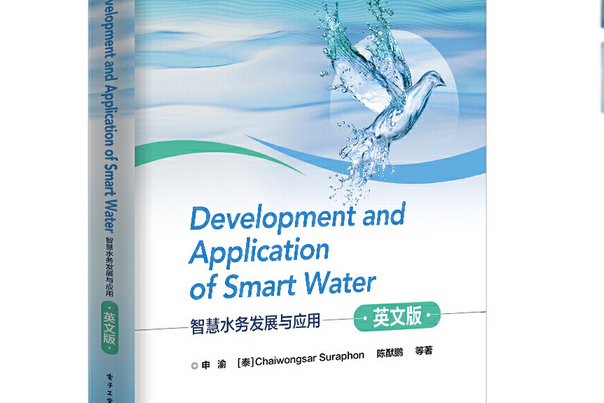《智慧水務發展與套用(英文版)》是2020年電子工業出版社出版的圖書,作者是申渝 。
基本介紹
- 書名:智慧水務發展與套用(英文版)
- 作者:申渝
- 類別:水資源調查與水利規劃類圖書
- 出版社:電子工業出版社
- 出版時間:2020年9月
- 頁數:296 頁
- 定價:69 元
- 開本:16 開
- 裝幀:平裝
- ISBN:9787121395949
內容簡介,圖書目錄,作者簡介,
內容簡介
智慧水務是近年來快速發展的行業,具有廣闊的套用前景和市場需求。本書從水務系統發展演變出發,總結當前水務行業面臨的挑戰與機遇,匯總水務行業發展的瓶頸問題及潛在解決方案,分析判斷水務系統智慧化升級的行業需求、政策引導、技術可行性和發展智慧水務大趨勢;按照智慧供水和智慧污水兩大類,系統梳理智慧水務套用現狀,以及典型套用場景的原理和技術方案,對比國內外的智慧水務發展狀況,從感測器、執行器、物聯網和人工智慧技術等層面討論了智慧水務領域的發展前景。
圖書目錄
Contents
Part 1?Development of Water System
Chapter 1?Current Situation and Challenges of Water System 2
1.1?Overview of water system 2
1.2?Current situation of water system 6
1.3?Challenges facing the water industry 7
Chapter 2?Comparison of Domestic and Overseas Water Development 11
2.1?Water supply in China 11
2.2?Wastewater treatment in China 15
2.3?Overseas water development 18
2.3.1?Water development in the US 18
2.3.2?Water development in the UK 20
2.3.3?Water development in Thailand 23
Chapter 3?Development Trend of Water Industry—Smart Water 26
3.1?Proposed measures for water industry development 26
3.1.1?Informatization of water affairs 26
3.1.2?Making software and hardware more intelligent 28
3.2?Overview of smart water 29
3.2.1?Introduction and advantages of smart water 29
3.2.2?Stages of smart water development 31
3.2.3?Prospect of smart water 32
3.3?Smart water related technologies 34
Part 2?Smart Water Supply System
Chapter 4?Intelligent Management Technology for Drinking Water Sources 38
4.1?Current situation of drinking water sources in China 38
4.1.1?Classification of water sources and protected areas 38
4.1.2?Water quality and quantity standards for water sources 39
4.1.3?Assessment of water source safety 42
4.2?Water source management theory and technology 46
4.2.1?Water source management theory 46
4.2.2?Current situation and countermeasures of water source management 46
4.2.3?Intelligent management technology for water sources 49
4.3?Typical design scheme for intelligent management of water sources 52
4.3.1?Design of intelligent monitoring for water sources 52
4.3.2?Intelligent scheduling design for water sources 55
Chapter 5?Intelligent Control Technology for Water Supply Treatment System 56
5.1?Water supply treatment 56
5.1.1?Water supply treatment theory 56
5.1.2?Basic process of water supply treatment 56
5.1.3?Status quo of water supply treatment 57
5.1.4?Intelligent control of water supply treatment 58
5.2?Automatic control of core process units 59
5.2.1?Automatic control of water intake pumping station 59
5.2.2?Automatic control of dosing 60
5.2.3?Automatic control of filter tank 63
5.2.4?Automatic control of chlorination 63
5.3?Typical design scheme for intelligent control of water supply treatment system 65
5.3.1?Intelligent control system 66
5.3.2?Water quality management system 67
5.3.3?Equipment management system 69
Chapter 6?Smart Operation and Maintenance Technology for Water Supply Pipe
????? Network System 70
6.1?Monitoring methods for water supply pipe network 71
6.1.1?Water quality monitoring 71
6.1.2?Water pressure monitoring 73
6.1.3?Discharge monitoring 74
6.2?Model of water supply pipe network 75
6.2.1?Hydraulic model 76
6.2.2?BP neural network 81
6.3?Intelligent operation and maintenance of water supply pipe network 84
6.3.1?Optimal scheduling 84
6.3.2?Leakage control 85
6.3.3?Safeguards for secondary water supply 87
6.3.4?Visualization technology for operation and maintenance management 90
6.4?Typical design scheme for intelligent operation and maintenance of water
supply pipe network 92
6.4.1?Monitoring system 94
6.4.2?Leakage control 95
6.4.3?Optimal scheduling 96
Chapter 7?Intelligent Service Technology at User Side 97
7.1?Intelligent monitoring and early warning services 98
7.1.1?Intelligent monitoring service 98
7.1.2?Intelligent early warning service 100
7.2?Intelligent customer service 100
7.2.1?Making customer service center intelligent 102
7.2.2?Online service platform 103
7.2.3?Intelligent business hall 103
7.3?Typical design scheme for intelligent service system at user side 104
Part 3?Smart Wastewater System
Chapter 8?Forecast of Wastewater Quality and Quantity into WWTPs 108
8.1?Demand for forecast of wastewater quality and quantity 108
8.2?Wastewater quality and quantity forecast technology 109
8.2.1?Establishment of peripheral database 110
8.2.2?Prediction of wastewater quality and quantity 114
8.3?Typical design scheme 115
8.3.1?Technology adopted in the scheme 115
8.3.2?Specific design scheme 116
Chapter 9?Intelligent Operation Technology for Wastewater Treatment Facilities 119
9.1?Status quo and demand of wastewater treatment facilities 119
9.1.1?Status quo of wastewater treatment facilities 119
9.1.2?Problems with wastewater treatment facilities 125
9.1.3?Requirements of wastewater treatment facilities 130
9.2?Intelligent monitoring system for facilities 131
9.2.1?Significance of data monitoring 131
9.2.2?Main monitoring parameters 132
9.2.3?Monitoring data application 133
9.3?Intelligent control technology and equipment for facilities 134
9.3.1?Classification of automatic control technologies 134
9.3.2?Commonly used wastewater control strategies 136
9.3.3?Common intelligent control equipment 138
9.4?Typical design scheme for upgrading wastewater treatment facilities 141
9.4.1?Architecture and design of monitoring system 141
9.4.2?Design scheme for efficient lift pumping station 150
9.4.3?Design scheme for fine aeration system 153
9.4.4?Design scheme for intelligent dosing system 156
Chapter 10?Intelligent Management Technology for Wastewater Treatment System 158
10.1?Data modeling scheme 159
10.1.1?Scheme for ANN model 159
10.1.2?Scheme for support vector machine model 160
10.1.3?Scheme for regression analysis model 161
10.2?Scheme for mechanism model 162
10.2.1?Activated sludge model 163
10.2.2?ASM-based commercial software 165
10.3?Scheme for merging of mechanism and data models 165
10.3.1?Scheme for fusion of average values 166
10.3.2?Scheme for fusion weighted average values 166
10.3.3?Scheme for fusion of conservative values 167
10.3.4?Scheme for f (x,θ) fusion 168
10.4?Scheme for plan library 170
Chapter 11?Cloud Management Technology for WWTPs Group 173
11.1?Requirements for WWTPs group cloud management 174
11.1.1?Development status and competition pattern of wastewater treatment
industry 175
11.1.2?Necessity of WWTPs group cloud management 178
11.1.3?Feasibility of WWTPs group cloud management 179
11.1.4?Value of applying WWTPs group cloud management 181
11.2?Principle and technology of WWTPs group cloud management 182
11.2.1?Basic principles of WWTPs group cloud management 182
11.2.2?Objectives of WWTPs group cloud management 183
11.2.3?WWTPs group cloud management technology and solution 185
11.2.4?Functions and description of WWTPs group cloud management 187
11.3?Design scheme for WWTPs group cloud management platform 188
11.3.1?Design principles of WWTPs group cloud management platform 188
11.3.2?Remote visual management of plant group site 190
11.3.3?Concentrated management and intelligent maintenance of equipment 191
11.3.4?Real-time monitoring of plant group production safety 192
11.3.5?Economic operation of plant group equipment 194
Part 4?Application Status and Prospect of Smart Water
Chapter 12?Application of Smart Water Supply System 198
12.1?Intelligent and integrated water source management system 199
12.1.1?Intelligent management system of water source well 199
12.1.2?Intelligent management system of water intake pumping station 202
12.2?Intelligent management system of waterworks 204
12.2.1?System application 204
12.2.2?System composition 205
12.2.3?System functions 206
12.2.4?Equipment configuration 207
12.3?Int
作者簡介
申渝,男,1981年生,博士,研究員,重慶工商大學、中國科學院大學研究生院碩士生導師(管理科學與工程、環境科學與工程),環境保護部製藥廢水治理與資源化創新產業聯盟副秘書長(2014年),重慶市城市污水控制項目專家組成員(2015年)。主要研究領域為環境大數據管理、環境裝備設計與運行管理等。近年來,主持國家科技部、重慶市科技局等省部級及以上項目/課題9項,累計科研經費2000多萬元,發表SCI論文38篇,獲得授權專利6件。

